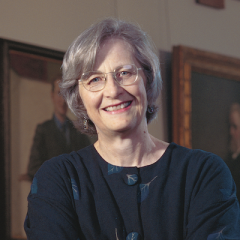Laurel Thatcher Ulrich was born in 1938 in Sugar City, Idaho. She graduated from the University of Utah in 1960 with a BA in English. That fall she moved with her husband, Gael Ulrich, to Boston, Massachusetts so he could begin graduate work at MIT (Massachusetts Institute of Technology). During the next ten years, while engaged with her growing family, she worked with a dynamic group of Mormon women to produce a popular guidebook to Boston (a fund-raising project for their local congregation) and helped to found a Mormon feminist newspaper. Exponent II (now a magazine available in print or on-line). Taking one course a semester, she completed an MA in English at Simmons College in 1971.
By then, she and her family had moved to Durham, New Hampshire, where Gael took a faculty position in the Engineering School at the University of New Hampshire. Taking advantage of tuition benefits available to faculty wives, she gradually shifted her focus from literature to history. After completing Ph.D. in Early American History in 1980, she accepted a part-time position administering a freshmen humanities program at UNH. She published her revised dissertation Good Wives with Alfred A. Knopf in 1982 . Her second book, A Midwife’s Tale followed in 1990. By then, she had become a full- time member of the UNH history department.
In 1995, she accepted a position at Harvard University as James Duncan Phillips Professor of Early American History and Professor of Women’s Studies. She published The Age of Homespun in 2001, and in 2004 worked with students, colleagues, and alumnae to produce Yards & Gates: Gender in Harvard and Radcliffe History. In 2006, she became 300th Anniversary University Professor, a recognition in part of her ability to engage in interdisciplinary scholarship and teaching especially in Harvard’s many museums. In 2007 she published Well-behaved Women Seldom Make History and in 2015 Tangible Things: Writing History Through Objects , co-written with Ivan Gaskell, Sara Schechner, and Sarah Anne Carter.
Her 2017 book, A House Full of Females: Plural Marriage and Women’s Rights in Early Mormonism, 1835-1870, uses several of the strategies developed in her earlier work to develop a series of counter narratives to dominant themes in the history of the development and westward movement of the Church of Jesus Christ of Latter-day Saints. She is now deeply engaged in a study of the intersection of race, religion, and women’s rights in the United States from the Revolution to 1920.
After retiring from Harvard in 2018, she moved with her husband to Bala Cynwyd, Pennsylvania.

